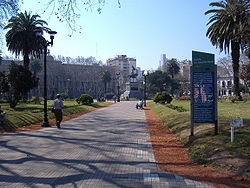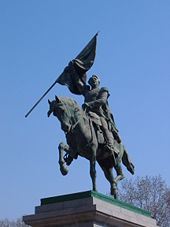
Plaza San Martín (Rosario)
Encyclopedia


Plaza
Plaza is a Spanish word related to "field" which describes an open urban public space, such as a city square. All through Spanish America, the plaza mayor of each center of administration held three closely related institutions: the cathedral, the cabildo or administrative center, which might be...
(urban square) in Rosario
Rosario
Rosario is the largest city in the province of Santa Fe, Argentina. It is located northwest of Buenos Aires, on the western shore of the Paraná River and has 1,159,004 residents as of the ....
, province
Provinces of Argentina
Argentina is subdivided into twenty-three provinces and one autonomous city...
of Santa Fe
Santa Fe Province
The Invincible Province of Santa Fe, in Spanish Provincia Invencible de Santa Fe , is a province of Argentina, located in the center-east of the country. Neighboring provinces are from the north clockwise Chaco , Corrientes, Entre Ríos, Buenos Aires, Córdoba, and Santiago del Estero...
, Argentina
Argentina
Argentina , officially the Argentine Republic , is the second largest country in South America by land area, after Brazil. It is constituted as a federation of 23 provinces and an autonomous city, Buenos Aires...
. Its name is an homage to General José de San Martín
José de San Martín
José Francisco de San Martín, known simply as Don José de San Martín , was an Argentine general and the prime leader of the southern part of South America's successful struggle for independence from Spain.Born in Yapeyú, Corrientes , he left his mother country at the...
, hero of the Argentine War of Independence
Argentine War of Independence
The Argentine War of Independence was fought from 1810 to 1818 by Argentine patriotic forces under Manuel Belgrano, Juan José Castelli and José de San Martín against royalist forces loyal to the Spanish crown...
.
Plaza San Martín is located in the downtown area of Rosario, occupying the block defined by Santa Fe St., Dorrego St., Córdoba St.
Córdoba Street (Rosario)
Córdoba Street is one of the most important streets in Rosario, Santa Fe Province, Argentina. It runs east–west through the center of the city, from the coastal avenue by the Paraná River to the western limit of the urbanized area....
and Moreno St., along the historical segment of Córdoba St. called Paseo del Siglo
Paseo del Siglo
Paseo del Siglo is a part of the historical center of the city of Rosario, Argentina. It comprises eight blocks in the downtown Córdoba Street, from Oroño Boulevard east up to Paraguay Street...
. In the center of the plaza there is a bronze
Bronze
Bronze is a metal alloy consisting primarily of copper, usually with tin as the main additive. It is hard and brittle, and it was particularly significant in antiquity, so much so that the Bronze Age was named after the metal...
statue of General José de San Martín, mounted on a horse and carrying a flag. The statue is a copy of a monument erected in the French city of Boulogne-sur-Mer
Boulogne-sur-Mer
-Road:* Metropolitan bus services are operated by the TCRB* Coach services to Calais and Dunkerque* A16 motorway-Rail:* The main railway station is Gare de Boulogne-Ville and located in the south of the city....
(the place of San Martín's voluntary exile and death), and was inaugurated on 21 May 1913.
The plaza is flanked by important buildings, among them the former Tribunals Palace, now seat of the Faculty of Law of the National University of Rosario
National University of Rosario
The National University of Rosario is a research, educational and public university located in the city of Rosario, province of Santa Fe, Argentina.-Overview:...
and of the Dr. Ángel Gallardo Provincial Natural Sciences Museum
Dr. Ángel Gallardo Provincial Natural Sciences Museum
The Dr. Ángel Gallardo Provincial Natural Sciences Museum is a public museum in Rosario, Argentina, specialized in biology...
, and the former headquarters of the Santa Fe Provincial Police, now a delegation of the provincial government and host to a small museum of the last dictatorship (Centro Popular de la Memoria
Centro Popular de la Memoria
The Centro Popular de la Memoria is a former illegal detention center in Rosario, . It was used by the provincial police between 1976 and 1979, during the Dirty War, to hold people with no formal charges and torture them, under the pretense of fighting radical left-wing political subversion and...
).
History
The land where the plaza is located was donated by Marcos PazMarcos Paz
Marcos Paz was Governor of Córdoba and Tucumán Provinces, an Argentine Senator, and Vice President of Argentina from October 12, 1862 until his death in 1868.-Biography:...
in 1857, and was much larger than at present (extending several blocks to the south). Its purpose was to serve as a marketplace, where cargo wagons that came and went between Rosario and other cities farther away from the littoral would stop to load and unload.
When the railway system was established, in 1871, the municipal government projected to build a square, which was referred to as Plaza San Martín already in 1884, while it was still an empty lot. In 1888, the municipality gave up most of the land for the construction of the Tribunals, leaving the terrain with its current dimensions. In 1891 mayor Gabriel Carrasco had gardening works begin on the site.

